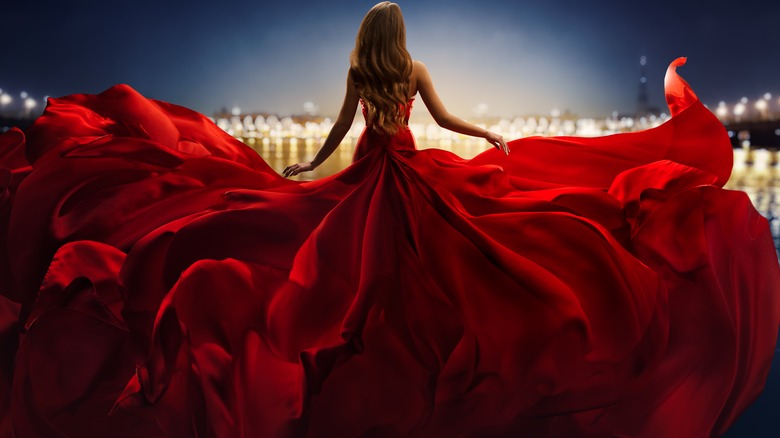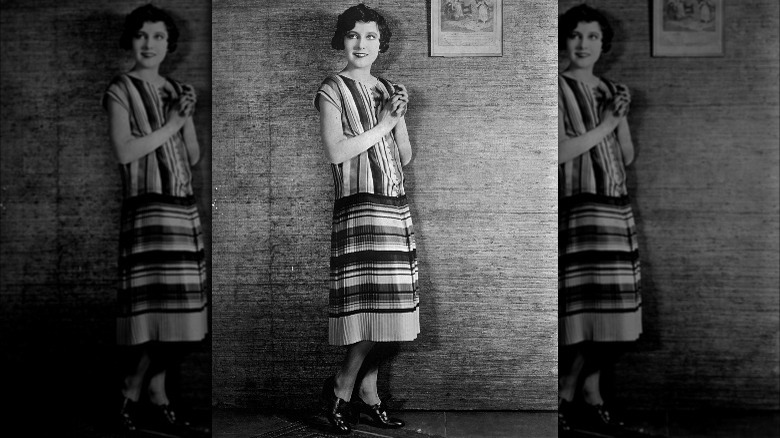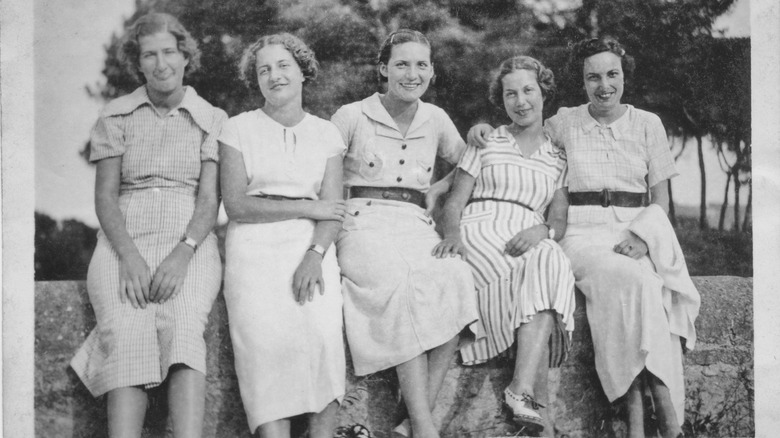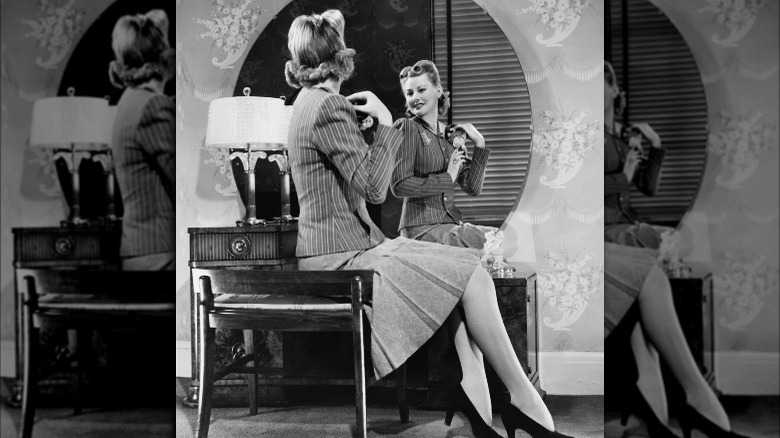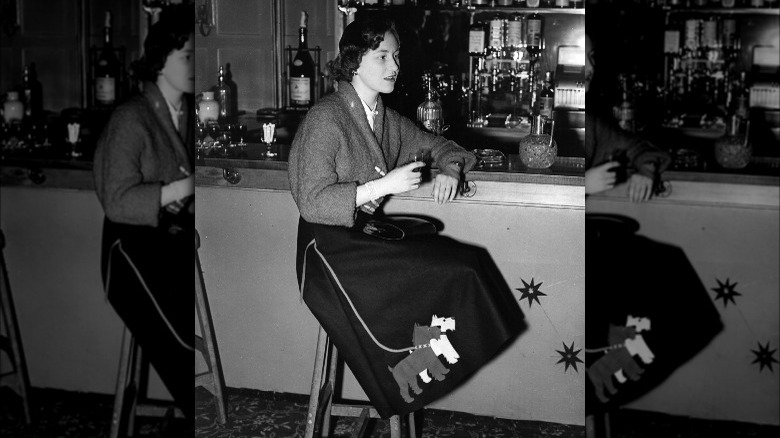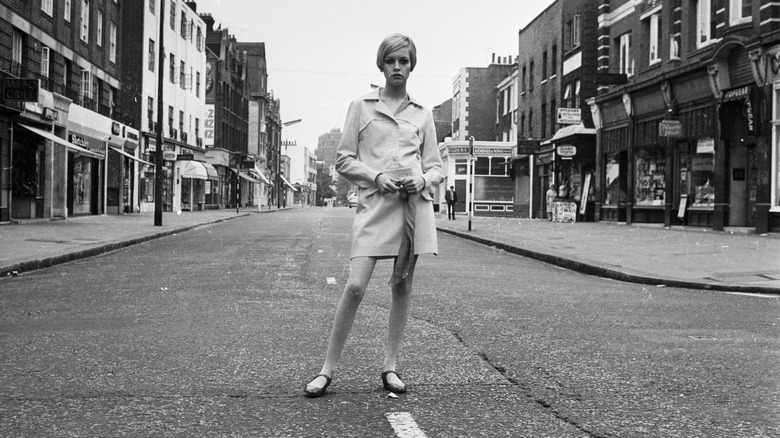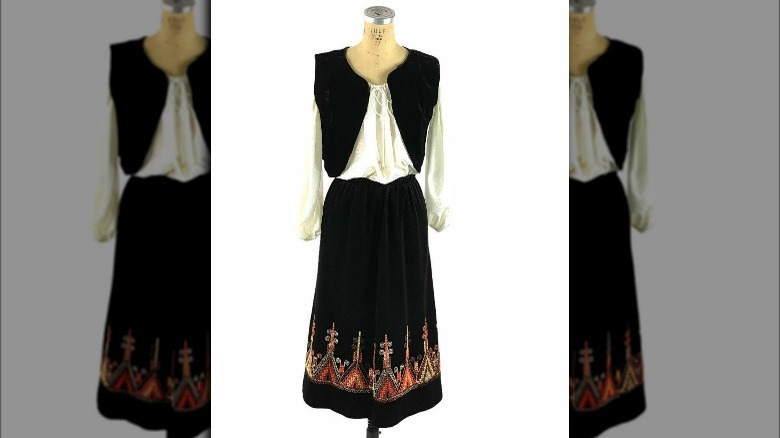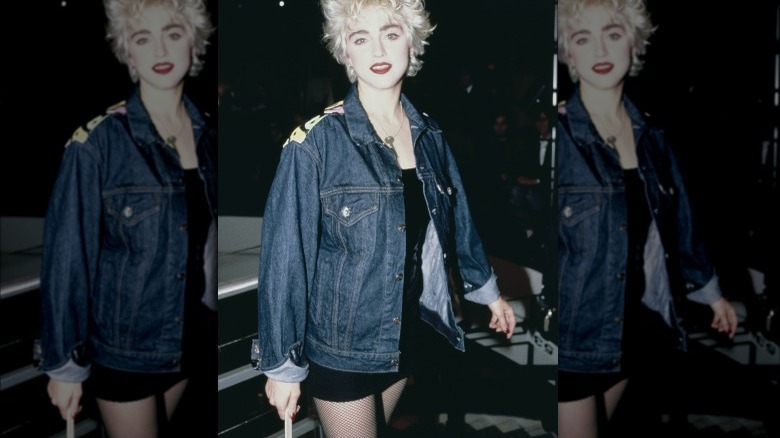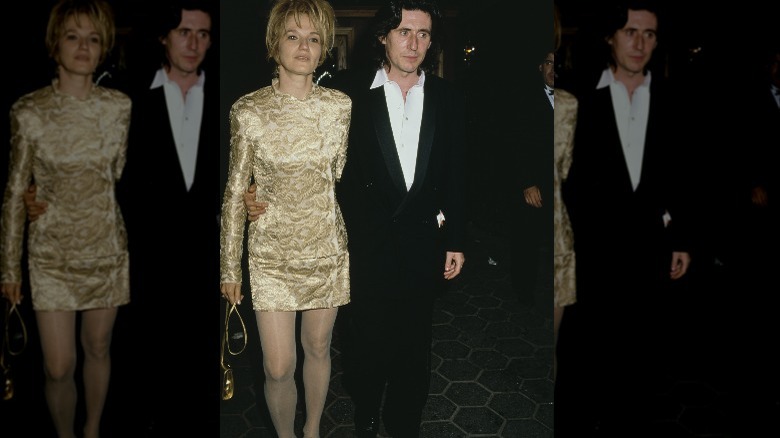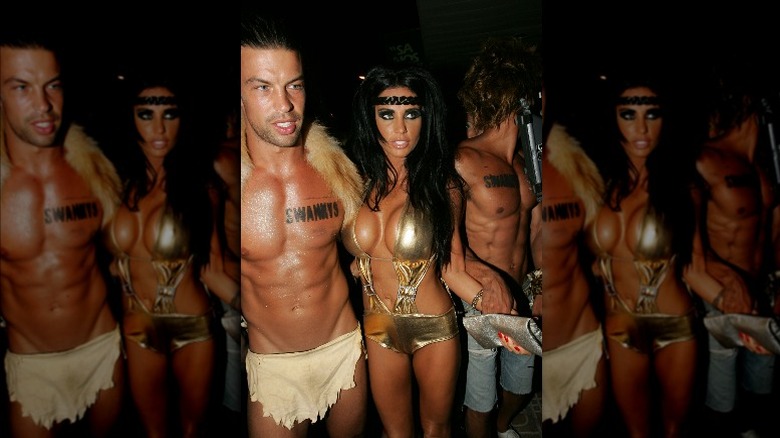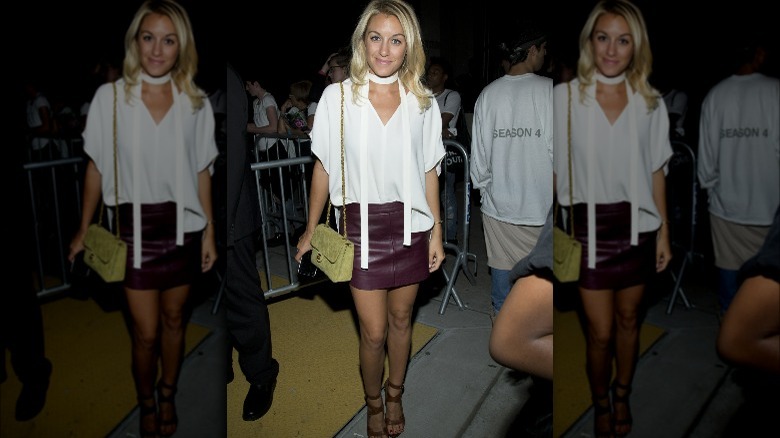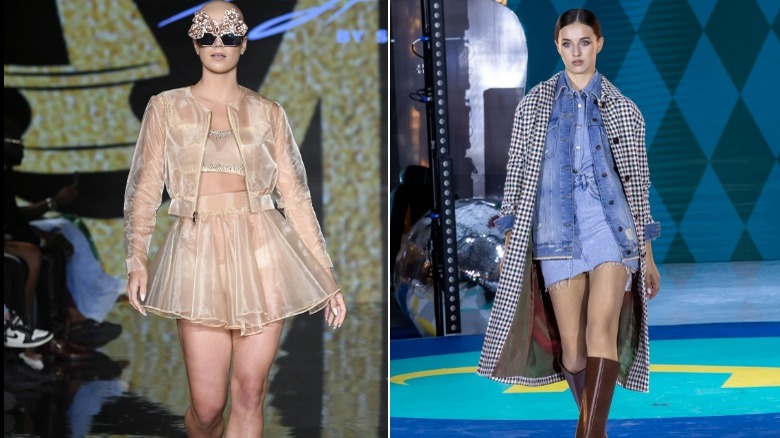100 Years Of Fashion: Skirts
No one can really say when and where the first skirt in history was worn because it had to have been long before history came to be recorded, according to Runway Magazines. The skirt is, after all, one of the most rudimentary fashion staples imaginable. At its most basic, the skirt is nothing more than a gender-neutral draping of some material or other, whether animal skin, woven straw or fabric, etc., that's gathered or wrapped around the waist for the purpose of covering some portion of the lower body.
The oldest physical skirt, which was made of woven straw and discovered in Armenia, per News.am, is estimated to be 5,900 years old. However, Runway notes that archeologists have found evidence of skirts being worn as far back as at least 7,700 years. During ancient times, skirts were simply "standard attire," regardless of gender. In fact, the feminization of skirts is a modern concept dating back to the 19th century, per GUAP.
Nevertheless, the skirt has become so synonymous with femininity that the word, itself, is slang for a person of the female gender, per Merriam-Webster. Indeed, the evolution of skirt fashion has much to inform us, but not just about gender politics. We might even go so far as to say that the predominant skirt styles and lengths during each decade over the last 100 years have much to reveal about then-prevailing cultural and historical realities.
1920-1929: Fun with hemlines, part 1
Until the 1920s, women wore their skirts long — either ankle length or to the floor, according to Women's History Network. Starting in the 1920s, hemlines began rising, according to Professor Lynn Richards of the Department of Clothing and Textiles at Texas Tech University (via Clothing and Textile Research Journal). As the hemlines of skirts rose, their waistlines dropped, resulting in a straight-up-and-down, or tubular silhouette, per the Library of Congress. Some refer to the look as androgynous, but, at the same time, it was deemed provocative because it reflected a newfound freedom of self-expression (via WHN).
Indeed, rather than restricting movement as they had in the past, skirts of the 1920s were increasingly designed to allow for movement, often via pleating or floaty handkerchief hemlines. This coincided with a celebratory zeitgeist that characterized the post-World War I years as well as the fact that large numbers of women had entered the industrialized workforce for the first time in history during the war, making it increasingly less practical for skirts to "hobble" or otherwise constrict the movement of their wearers (per The New York Times).
In addition, the 1920s saw the rise of women wearing "separates," which is to say a separate bottom and top. There was freedom in separates, symbolizing women's desire to move about more freely throughout their world — the way men have always done.
1930-1939: A bias toward curves
The stock market crash of 1929 has long been believed to have had a sobering effect on women's fashion in a way that Prohibition's sober agenda had not managed to do (via Clothing and Textile Research Journal), although it may be a matter of correlation, rather than the cause, according to Dr. Lynn Richards (via Clothing and Textile Research Journal). In either case, by the dawn of the 1930s, hemlines had begun dropping toward the floor once again. Additionally, the waistline made an encore appearance, according to the Library of Congress. For all the strides women had been making toward equality, 1930s skirt styles saw a marked return to the old standard, which was putting feminine curves on display.
Moreover, one of the biggest fashion developments of the 1930s was the rise of bias-cut fabric in constructing skirts. Cutting on the bias refers to cutting fabric on the diagonal, which is to say, against the weave of the fabric, per Fashion Institute of Technology (FIT). While seemingly a minor detail, cutting on the bias can significantly change the look of a garment. To wit, bias-cut fabrics flow and drape softly along the lines of a woman's body so that a skirt need not be tight in order to highlight a woman's curves.
Nevertheless, as the decade progressed, hemlines once again began to rise. According to Vintage-Retro, the midi skirt (falling just below the knee) became the most popular style of the decade.
1940-1949: Fun with hemlines, part 2: wartime edition
At the dawn of the 1940s, the U.S. was still in the throes of economic depression. Accordingly, whereas the prosperity of the early 1920s literally gave rise to shorter hemlines, the economic realities of the early 1940s ushered in a more conservative look. Although skirts were still falling to just below the knee, the prevailing silhouette came to be less shape-revealing. For example, A-line skirts, which are relatively shapeless despite featuring a nipped-in waist, began trending, per Vintage Dancer.
When the U.S. entered World War II in 1941, wartime rationing of raw materials ensured hemlines would remain at midi length and not an inch longer. Embellishments such as ruffles and flounces disappeared. Even pockets were disallowed — but only on skirts and dresses; men's clothing always employed this convenience. Ironically, however, this was a time in which more women were going out into the workforce, according to Pieces of History.
But that also meant that skirts simply had to be roomy enough to move about freely in, per Vintage Dancer. When fabric rationing made that a challenge, designers added kick pleats. Indeed, pleating came back with a vengeance during the second half of the 1940s after wartime restrictions ended. "The overall shape was still A-line," Vintage Dancer notes, "but pleating added a bit more swing to a woman's step, a sign of post-war joy."
1950-1959: The New Look was luxe
One way of describing a stylish look is to call it "fashion forward," per Mood Sewciety. The word "forward" is meant to suggest high fashion is ahead of its time. To wit, in 1947, designer Christian Dior debuted a style he dubbed the "New Look," per Google Arts & Culture, but it only really hit the mainstream starting in the 1950s (via Vintage Dancer). When it finally did, this ultra-feminine look, featuring a full skirt and an unforgiving waistline, became the prevailing look of the 1950s.
Thematically, it was a rejection of the sack-like and A-line styles that had prevailed earlier in the century, per Google Arts and Culture. Indeed, 1950s skirts came to re-embrace the waist-conscious look that had been popular throughout the Edwardian era and decades prior. According to Vintage Dancer, 50s skirts aimed to highlight the contrast between a girdled waist and a full skirt made with as much as five yards of fabric. It also became de rigueur during the 1950s to further emphasize the waist with a decorative belt or sash as well as to emphasize the wide hem of the skirt with an applique avatar, often a poodle.
By the end of the 1950s, the U.S. economy had grown by 37%, and skirt styles reflected American prosperity, employing all manner of embellishment, from button-fronts to generous gathering at the waist to flounces and tiers. What didn't change, however, were hemlines; the knee-length midi continued its reign.
1960-1969: the miniskirt emerges
Like Dior's New Look, which debuted in the 1940s but rose to mainstream popularity only in the 1950s, slim "pencil" skirts caught on among the fashion-forward crowd during the 1950s, according to Vintage Dancer, but it would not be until the 1960s that pencil skirts were embraced by the mainstream public, per Fashion Institute of Technology (FIT). Plenty of women were still wearing the tiny-waisted, wide-bottomed circle skirts that had become broadly popular during the 1950s, but increasingly, there came to be an interest in skirts that more closely skimmed the hips.
Since pencil skirts restrict movement, making them shorter was a logical concession, and both designers and shoppers seemed happy to embrace it, per FIT. The rise of the mini happened more gradually than many might imagine, according to V&A. Nevertheless, the designer, Mary Quant, whom many credit with the miniskirt's invention, was already hiking up her own skirts as early as 1960. And by 1966, the miniskirt was everywhere.
On the other hand, the miniskirt was a look associated with youth, and even if it was appreciated by many, it wasn't adopted by everyone. In the second half of the 60s decade, some skirt hemlines began dropping to below the knee once again. The full-length maxi-skirt, as it's known, emerged in parallel with the growth of "hippie" culture as well as "street style," by which designers are influenced by the people, as opposed to solely the other way around.
1970-1979: From minis to maxis, anything goes
Like all decades, the 1970s began with a nod to the previous decade's styles, per Vintage Dancer. But whereas in other decades, the emerging looks quickly came to eclipse existing styles, in the 1970s, skirts came in all lengths and silhouettes — perhaps more broadly than in any prior decade. As Vintage Dancer writes, "Seventies fashion was a mish-mash, a bit of everything for anyone who had an opinion about fashion."
That meant that walking down a city street, say in London or New York City, one might see one woman wearing a micro-miniskirt with go-go boots striding alongside a woman sporting a long, flowy, peasant-style skirt, which the designer Jessica McClintock popularized with her calico prairie look. But you might also see women wearing straight skirts that hit at the knee. Essentially, the 1970s represented a time in which the prevailing fashion sentiment was "anything goes."
The fact that more Americans owned televisions than ever may have played a role as well. Starting in the 1960s, people increasingly looked to television stars for fashion cues and inspiration, according to The New York Times. Mary Tyler Moore, whose eponymous series debuted in 1970, was a prime example. Her character, a single woman who worked in a male-dominated newsroom and lived alone in a studio apartment, went to her first day of work in a miniskirt and go-go boots. By the end of the series in 1977, Moore's character was wearing a one-piece pants suit.
1980-1989: Punk versus professional
At the dawn of the 1980s, more and more women were not only entering the workforce, but they were doing so with an eye to shattering the glass ceiling, according to Marie Claire. As in other times in history during which women began seeking access to male-dominated institutions, they did so in skirts (and heels, albeit not necessarily backwards). Accordingly, the skirt suit became a veritable uniform of the career woman while also becoming "a symbol of power in the workplace at a pivotal time when women challenged men for equality," notes fashion historian Kimberly Chrisman-Campbell to Marie Claire.
In 1985, however, the designer Jean-Paul Gaultier sought to even the playing field — for skirt-wearing. He came out with the first high-fashion skirt designed for the male body, according to the Fashion Institute of Technology. While it didn't catch on in offices, it nonetheless contributed to fashion's increasingly fluid mores, including the eventual welcoming of women's suits with pants, rather than skirts. The skirts that were popular for the so-called "power suits" tended to be rather voluminous A-line midis, per Vintage Dancer.
At the same time, musicians were becoming fashion icons — especially Madonna, who transformed the punk fashions from the 1970s into her own unique look, which began with miniskirts leggings and was accessorized with rubber bracelets and combat boots, per Barnebys Magazine. As the decade progressed, skirt design expanded further to include high-low hemlines, drop waists with flared skirts, and the "pouf."
1990-1999: Skirts so short they shocked
As the 1990s dawned, the spectacular economic growth of the 1980s came rapidly to a close, per the Bureau of Labor Statistics, which dates the recession to July 1990. Movies like 1994's "Reality Bites" illustrated a vast cultural divide between yuppie culture and grunge, but what was lost on many at the time was how much these dueling subcultures were actually influencing one another, at least in terms of fashion.
One designer on whom this was not lost was Marc Jacobs, whose Grunge collection put him — and grunge fashion — on the map even as that same collection provoked the firing of Jacobs from Perry Ellis, per Vogue. As one faction accessorized comfy, shapeless skirts with combat boots, the other climbed the corporate ladder wearing skirts so short they might have shocked Mary Quant, per Tampa Bay Times. Even as television's "Ally McBeal" and "Melrose Place" featured ambitious young women in skirts barely covering their private parts, real-life professional women were rounding out their work wardrobes with flower-print skirts and sundresses — a product of grunge culture.
Is it any wonder then that the workplace soon came to embrace the wearing of pants by women? Were skirts finally losing their cultural relevance? The answers become apparent as the first millennium of the modern age drew to a close.
2000-2009: Skirts come full circle
At the start of the early aughts, Ally McBeal's micro miniskirts continued on as a cultural touchstone, according to Fashion Institute of Technology (FIT). But soon enough, September 11, 2001 came along; and its tragic events and extended fallout moved the cultural pendulum back into more conservative territory. Not only were pants suits in, but suddenly women were seen wearing pants under their skirts, according to Lofficiel USA. Not only were miniskirts perfectly fine to wear to the office, but so too were tight-fitting long-line pencil skirts, per FIT. Even the trumpet skirt, which had been popular during the Edwardian era made a comeback (via Who What Wear).
Not that miniskirts were going out of style. In fact, Study Finds reports that a 2020 Samsung survey of 2,000 people in the U.K. revealed that miniskirts are not only here to stay, but more people consider the miniskirt to be THE most "iconic fashion trend in history," edging out the little black dress, skinny jeans, bootcut jeans, high-waisted jeans, and frayed jeans.
Nor was the grunge look going anywhere, except that in the late 2000s, it morphed into "boho chic," per FIT. According to Azyaamode, boho chic melded grunge with hippie style with a new trend toward crafting and an interest in all things homemade. With the handmade aesthetic growing in popularity, it was as if the end of the early aughts saw skirt fashion coming full circle — back to its hand-forged origins.
2010-2019: Rumors of the skirt's demise?
As easy as skirts are to style, wear, and accessorize, as the first decade of the new millennium was winding down, it became clear that skirts were losing ground to both dresses and the many options that had become available in pants, via You Look Fab, a blog which addressed this phenomenon right at the start of the 2010s. "I'd rather wear my dresses, walk shorts, and jeans along with my boots," they wrote. But they also noted that skirts weren't exactly down for the count.
In fact, the 2010s saw the rise of skirts as part of an "athleisure"-driven wardrobe, which, itself had become all the rage, per the Fashion Institute of Technology (FIT). Suddenly, tennis skirts entered the everyday rotation, as well as the schoolgirl-inspired mini and the figure-skating-inspired flared skirt, via Stentor. But while tiny skirts continued to proliferate, the 2010s also saw a resurgence of pencil skirts, and later, fuller and longer skirts, according to FIT. For reasons that remain unclear, even the pouf skirt, also known as the "bubble skirt" enjoyed an encore during this decade.
As for any rumors of the skirt's demise, let's just say they're greatly exaggerated, as the 2020s have demonstrated thus far.
2020 to the present: to be decided in hindsight
Some decades begin with a stylistic whisper, which is to say, it's challenging to delineate where the last one ended and the current one began. Despite that the 2020s began with the cultural tidal wave of the COVID-19 pandemic, it's challenging to identify one strong trend distinguishing now from then.
According to Varsity, for example, athleisure remains influential. Indeed, it's come full circle to encompass skirts as actual athletic wear. Of course, like many fashion trends, the trend toward running skirts and workout skirts has fashion forward origins dating back at least a decade, per Runner's World. To wit, in 2008, the Women's Olympic Marathon Trials saw one female athlete, Sally Meyerhoff, finish 20th while wearing a skirt. Other trends we've spotted include the layered skirt look and the return of the bubble skirt as well as the maxi skirt, especially done up in denim.
It's only two years into the 2020s, and here's what one fashion writer predicts we'll be seeing even more of: tennis skirts, midi skirts, midi pencil skirts, skirt suits, and relaxed-fit skirts (via Brunette from Wall Street). On the other hand, as we all understand at this point, having lived through 2020, it's impossible to predict what might happen going forward, but the past is always instructive. In fact, it's already looking as if the classic sweater and skirt combo so popular in the 1940s and 50s, per The New York Times, may soon reenter the zeitgeist.
